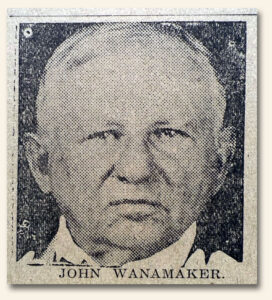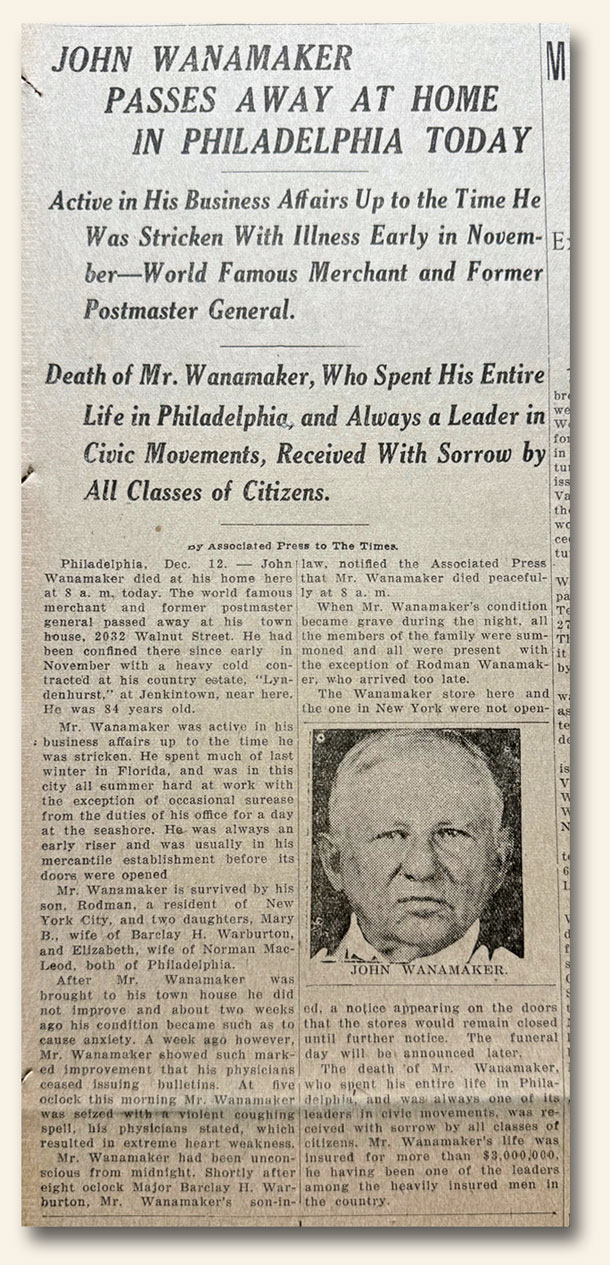Who’s Who in Newspapers – John Wanamaker edition
November 10, 2025 by GuyHeilenman · 1 Comment
Typically, our “Who’s Who in Newspapers” series highlights individuals who were unfamiliar to me before I delved into the world of Rare & Early Newspapers. Today’s post is a departure from that norm. While reviewing the December 12, 1922, issue of The Bethlehem Times, I came across a front-page report of John Wanamaker’s passing. The article stirred a flood of childhood memories tied to this remarkable man whose legacy left a lasting impression on me. Eager to share his story, I hope the following introduction sheds light on his extraordinary contributions.
John Wanamaker: The Merchant Who Made Shopping an Experience
 From personal memories to retail innovation, Wanamaker’s left a legacy that reshaped both commerce and tradition. Every December starting in the mid-1950s, my parents bundled up my siblings and me for a trip into Philadelphia to see the Christmas light and music show at Wanamaker’s (currently being converted into a mixed-use facility). To us, it was pure magic — thousands of twinkling lights, the sound of the great pipe organ, and crowds of families gathered in awe. With my grandmother working in the store during those years, Wanamaker’s always felt like more than a department store — it felt like part of our family’s story.
From personal memories to retail innovation, Wanamaker’s left a legacy that reshaped both commerce and tradition. Every December starting in the mid-1950s, my parents bundled up my siblings and me for a trip into Philadelphia to see the Christmas light and music show at Wanamaker’s (currently being converted into a mixed-use facility). To us, it was pure magic — thousands of twinkling lights, the sound of the great pipe organ, and crowds of families gathered in awe. With my grandmother working in the store during those years, Wanamaker’s always felt like more than a department store — it felt like part of our family’s story.
That sense of wonder was no accident. John Wanamaker (1838–1922), the man behind the store, believed shopping could be more than a transaction — it could be an experience. When he opened his Philadelphia department store in 1876, it quickly became a model for modern retail. Wanamaker pioneered the one-price system (no haggling), introduced the money-back guarantee, and used newspaper advertising on a scale few had seen before.
He also reshaped how Americans paid for what they bought. Realizing that many working families couldn’t afford to pay cash for larger purchases, Wanamaker offered installment plans and charge accounts. This bold move laid the foundation for consumer credit, opening the door for more households to access quality goods.
Beyond retail, Wanamaker served as U.S. Postmaster General under President Benjamin Harrison, introducing commemorative stamps and expanding rural mail delivery. Yet it was his Philadelphia store — both marketplace and civic landmark — that became his greatest legacy.
Even today, the memory of standing with my siblings beneath the glow of the light show while the Wanamaker organ thundered through the Grand Court remains a vivid reminder of how one man’s vision reshaped not just shopping, but tradition itself.
Wanamaker’s Firsts – Innovations that reshaped retail
- One-Price System – Ended the practice of haggling; everyone paid the same fair price.
- Money-Back Guarantee – Built customer trust and loyalty.
- Large-Scale Advertising – One of the first to use newspapers to reach wide audiences.
- Department Store Experience – Turned shopping into a cultural outing with art, music, and public events.
- Consumer Credit – Introduced installment plans and charge accounts, paving the way for modern credit.

Snapshot 1922… John who?
October 4, 2019 by GuyHeilenman · 2 Comments
Unless you grew up in the Philadelphia – New York City corridor, you may not recognize the name, but he certainly made his mark on American culture in general, and the Philly region in particular. Famed merchant, marketing pioneer, founder of one of the first major department stores, U.S. Post Master General, notable Christian philanthropist, and more, his name was recognized throughout the world in the mid-to-late 19th century. Until its closing, the Wanamaker Building was a frequent destination for most who visited Philadelphia, especially during the Christmas Season. Some of his more-famous quotes include: “People who cannot find time for recreation are obliged sooner or later to find time for illness.” “People who cannot find time for recreation are obliged sooner or later to find time for illness.” “Half the money I spend on advertising is wasted; the trouble is, I don’t know which half.”
As was reported in the December 12, 1922 issue of The Bethlehem Times, John Wanamaker met his Maker on the same day as this report. While his influence lives on through such simple things as “the price tag” (on products), his name is slowly succumbing to that which befalls us all. Still, those of us who know of his contributions appreciate his impact on society, and have fond memories of his Christmas Light Show and one of the most amazing pipe organs in the world. Thanks John.
Update from a comment posted as a follow-up to this post: “It is true that Wanamaker department store is closed, but since then, the building has housed two other department stores, Hecht’s and Macy’s. Both companies have continued the Christmas light and organ traditions. Macy’s, the current owner, even funded a multi-million dollar restoration to the light show. Going to Wanamaker’s at Christmas is still a yearly tradition that my family enjoys, and many a Philadelphian still “meet at the eagle,” on a daily basis.” Thanks Bill (see posted reply)
They Put It In Print… Schools need to teach The Constitution…
October 29, 2018 by GuyHeilenman · Leave a Comment
Human nature has a tendency to drive us to forget – to enjoy the bountiful privileges earned on the backs, and at times the very lives of those who have gone before us, but to forget the great cost paid to obtain them. After a few generations pass, the backdrop which drove such impassioned effort to earn them is also lost.
The year was 1922. It had been a mere 1.5 centuries since the ratification of The U.S. Constitution had paved the way for a new form of society, and there was already a deep-rooted concern that the unless citizens studied and learned the basic tenets of the Constitution, it would not stand. How do we know? The Virginia Pilot dated September 22, 1922 put it in print. Although its now nearly 100 years since the article was written, the call remains – perhaps even more-so. 
Anticipation enhanced by delayed gratification… King Tut…
June 11, 2018 by GuyHeilenman · Leave a Comment
A bride-to-be as her wedding day approaches… a young child the night before Christmas… a family as it heads off towards a long-awaited vacation destination (Can anyone hear, “Are we there yet?”)… a teacher during the last week of May – as the end of the year nudges closer… a groom as his wedding night draws near – there is no doubt that delayed gratification buoyed by a humongous helping of perseverance tends to make long anticipated events taste even sweeter. Such was to be the case for Howard Carter (archeologist – backed by financier George Herbert) as he entered the newly discovered tomb in late November of 1922 to find drawings related to the funeral of King Tutankhamun painted on the walls. After more than a decade of searching – failure built upon failure, could this be it? While newspapers would not report the opening of the inner tomb until February the following year, the front page of The New York Times from December 1, 1922 had the announcement of Carter’s initial find – with mention of the King Tut related drawings. One can only imagine the escalation in excitement this created – and the building of anticipation which occurred over the next few months. Unlike the opening of Al Capone’s vaults in 1986, this find would not disappoint! 
Wireless telephones in 1922… If only they knew…
January 26, 2017 by GuyHeilenman · 2 Comments
As far back as 1922 the international community, including the U.S., appreciated the potential benefits of wireless communication, but also understood it was fraught with problems. At the time their greatest concern was interruption of service due to interference from other devices. Of course we now know this “issue” was just the tip of a very dangerous (invasion of privacy) iceberg. How ironic the very institutions which were decrying the inherent drawbacks are now likely those who are exploiting them – at the expense of its citizens. Still, this early article found in the February 8, 1922 issue of the NY Times makes for interesting reading.




